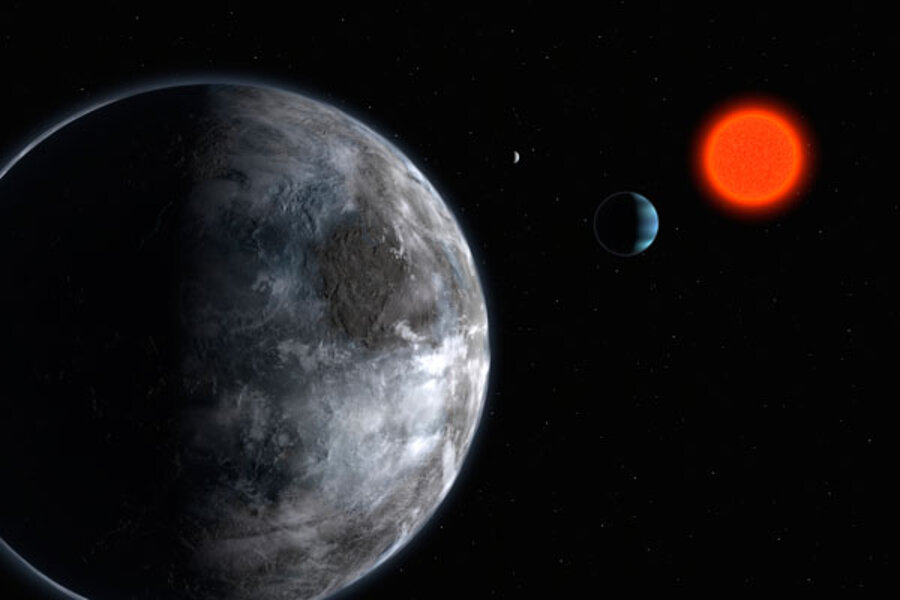Planet poseurs could confuse the search for extraterrestrial life
Loading...
Beware the habitable-planet poseur.
That's the caution from a team of astronomers arguing that ultraviolet radiation from a planet's host star can trigger the formation of key atmospheric gases, raising them to levels that could be misconstrued as signaling life, even though the planet is lifeless.
The findings could be of significant importance in the coming years as two new space telescopes search for planets potentially capable of harboring life.
The systems in question involve planets orbiting in the habitable zones of a class of stars known as M dwarfs.
M dwarfs are dimmer than the sun and contain anywhere from 8 to 50 percent of the sun's mass. They also account for an estimated 70 percent of all the stars in the galaxy, and about 75 percent of the stars in the sun's general vicinity. Their "mature" phase lasts about 10 times longer than does the sun's, in principal allowing more time for life to emerge and evolve.
Some researchers estimate that for every two M dwarfs in the galaxy, there is at least one Earth-mass planet orbiting in an M dwarf's habitable zone – the place where a planet receives enough energy from its star to sustain liquid water on its surface.
But therein lies the rub, the researchers say.
An M dwarf's habitable zone is far closer to the star than is the sun's habitable zone, which means any planets there might be buffeted by intense solar flares as well as life-threatening levels of radiation. Both M dwarfs and the sun emit far ultraviolet radiation as well as less damaging near ultraviolet radiation. But the ratio of far ultraviolet radiation to near ultraviolet radiation is about 1,000 times higher for M dwarfs than for the sun, according to the team's data.
This higher ratio could also trigger chemical reactions that could lead to deceptively high levels of molecular oxygen and ozone in the atmospheres of planets in M dwarfs' habitable zones. Astrobiologists have identified those two gases as markers suggesting the presence of life.
Sorting the planetary quick from the dead will become increasingly important with the launch of the Transiting Exoplanet Survey Satellite in 2017 and the James Webb Space Telescope a year later.
TESS will hunt for planets in the habitable zones of stars in the sun's neighborhood – largely M dwarfs. The James Webb Space Telescope has the capability to conduct follow-up studies of the planets TESS identifies. Those studies include attempts to characterize the atmospheres of the potentially habitable planets.
But as a biomarker, not all oxygen is created equal, said team leader Feng Tian of the National Observatories of China in Beijing during a briefing Monday.
"The result of this high ratio is that oxygen and ozone can build up in the atmosphere of a potentially habitable planet, even if the planet doesn't have life," he said.
Dr. Tian's team took an initial crack at the issue by examining Hubble Space Telescope data on Gliese 876, an M dwarf 15 light-years from the sun known to host four planets, including one orbiting in the star's habitable zone. But the planet is huge – a little more than half the mass of Jupiter. If surface water is present, it more likely would be on any moons the planet may host, rather than on the planet itself, astronomers say.
The team found that the ratio of far to near ultraviolet radiation was far larger from Gliese 876 than from the sun. They also modeled the impact of that ratio on the atmosphere of a hypothetical Earth-like planet in the star's habitable zone. They published the results of that work last year in the journal Astrophysical Journal Letters.
During Monday's briefing, they reported results of studies of additional M dwarfs and their ultraviolet mixes. One of the stars has up to three planets orbiting in its nominal habitable zone. The team has studied the emissions of six M dwarfs.
Beyond the different ratios of near to far UV, the team also found that the intensity of the emissions could vary by between 50 and 500 percent over time spans ranging from 1 to 16 minutes.
"For Gliese 876, we actually observed the ratio both during the flare phase and the quiet phase" of the star's cycle of magnetic activity, Tian said. "The ratio is pretty large in both phases," even though the overall levels of radiation vary as the phases change.
If the results hold up to further scrutiny, they would "send the cats among the pigeons in our confidence of O2, H2O and CO2 as biosignatures," noted Alain Ledger, an astrophysicist at the University of Paris in a prepared statement. Still, he added, this caution applies only to planets around M dwarfs. Planets orbiting in the habitable zones of sun-like stars are much farther away from their stars.
More work needs to be done to get a clearer sense of the potential impact of a M dwarf's mix of UV types on habitability, added Kevin France, a researcher at the University of Colorado at Boulder and a member of the research team.
The results were presented at an American Astronomical Society meeting in Denver, which runs through Friday








